Delidding The AMD Ryzen 5 2400G APU: How To Guide and Results
by Gavin Bonshor on May 10, 2018 8:00 AM EST- Posted in
- CPUs
- Guides
- APUs
- Ryzen
- Ryzen 3 2200G
- Ryzen 5 2400G
- Delidding
- Delid
Delidding The Ryzen 5 2400G Results and Conclusion
There has been a lot of hype since the launch of the Ryzen 2000 series APUs and in our Ryzen 5 2400G review, it’s noted that in multiple scenarios they outperform the competing Intel counterparts second to none in pixel rendering tests such as gaming, mainly thanks in no small part to the integrated iGPU featuring Vega cores. The aim of today’s testing with our best Ryzen 2000 series APU from a purely CPU frequency-based standpoint was to ascertain whether delidding makes a noticeable improvement to thermal performance, as well as determining if any extra headroom in CPU core frequency is made available.
As per our regular motherboard testing methodology when we find the max stable overclock, testing was done following the same procedure. Following on from the testing done in our Ryzen 2000 series APU overclocking guide, the aim in this was to continue with simple overclocking to push the core frequency.
To start, here are our initial overclocking results with the retail chip as sold:
After delidding the chip, replacing the paste with a liquid metal TIM, we achieved the following results:
Not only are the thermal properties improved from delidding and having the IHS slavered up with Thermal Grizzly Conductonaut liquid metal compound but operating at the previously unstable frequency of 4.2 GHz was made possible after delidding. Even at 4.2 GHz with the 2400G delidded, the temperatures hit the same levels as 4.0 GHz non delidded which is quite impressive. Even more monumental was the system managed to boot into Windows 10 at a clock speed of 4.3 GHz, although the system wouldn’t just hang when OCCT was fired up, it would crash completely meaning that even with a good AIO CPU cooler and being de-lidded, no more than 4.2 GHz was stable with this particular chip.
The best way to represent some of this data is in graphs. First up is the main one, temperature:
This is a clear representation showing the decrease in CPU temperature after the delidding process. The higher the frequency, the bigger the overall difference!
For power consumption, there was almost zero difference. This is to be expected: the chip will still consume the same amount of power with a standard temperature window. The cooler still has to remove the heat energy, however it is now being transferred better to the cooler through the new TIM.
The interesting result here is POV-Ray. We use POV-Ray in our overclock testing as it is usually very good if there are cache and memory errors associated with the high frequency. However here we see that beyond about 3.8 GHz, the retail processor has trouble getting more performance at a higher frequency, likely due to the CPU reaching thermal limits and the frequency mechanisms having to compensate. The end result is 'sustained' performance at higher frequencies. Due to the delid process, this was not an issue through to 4.2 GHz. Having the extra thermal headroom ultimately gave both more frequency and better sustained performance.
Is Delidding the Ryzen 2400G Worth it? Risk Versus Reward
As previously stated, the primary use where I could see delidding a Ryzen 2000 series APU viably applicable would be in a situation where cooling restrictions are in place such as a small form factor system or a HTPC. The benefits of the reduction in temperature would allow for a more svelte and slim line cooler to be used without pushing towards the maximum operating temperature.
Another less but pertinent use would be for performance users wanting faster clock speeds, although at a cost of voiding the warranty, potentially damaging and killing the chip itself during the process, and the added cost of the tools, it could be a price too much in retrospective which could be spent on a better CPU to begin with. Some vendors in the EU such as Caseking are actually selling pre-delidded Ryzen 3 2200G and Ryzen 5 2400G chips with their own warranties at an additional cost, which is often a better idea than manually performing the process and shelling out for the extra tools. That’s all good, providing this option is available to the user, although so far, I have yet to be able to find a large vendor offering this service in the US.


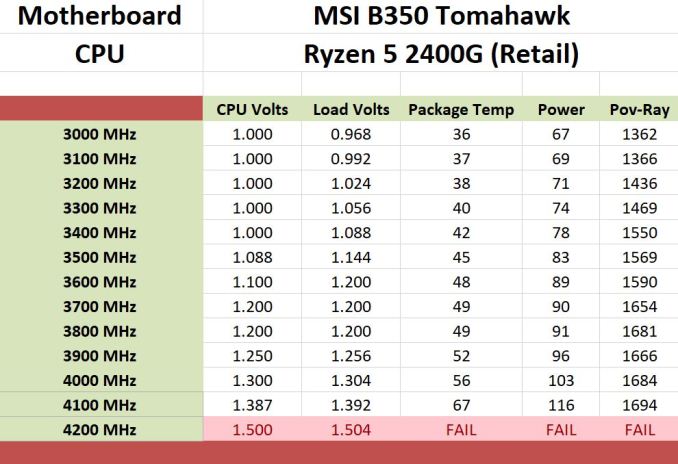
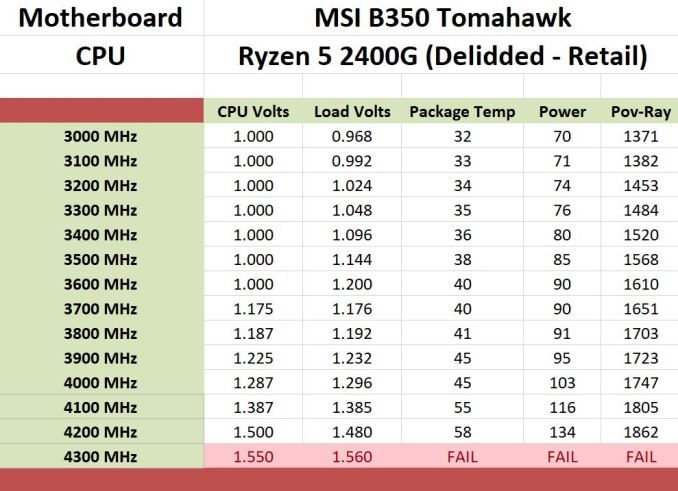
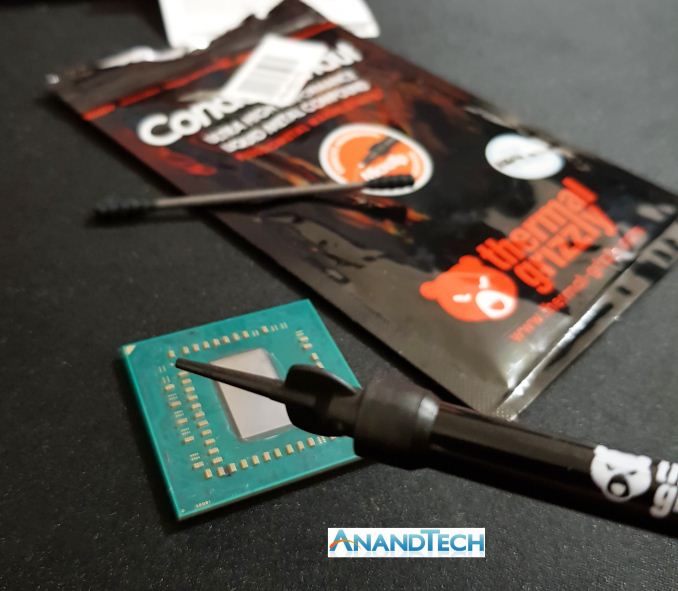
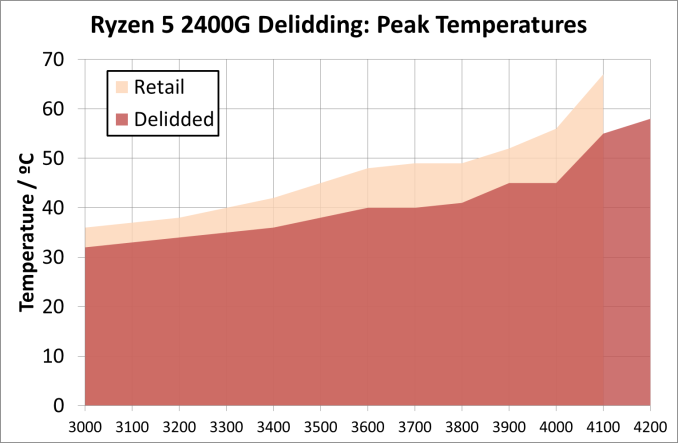

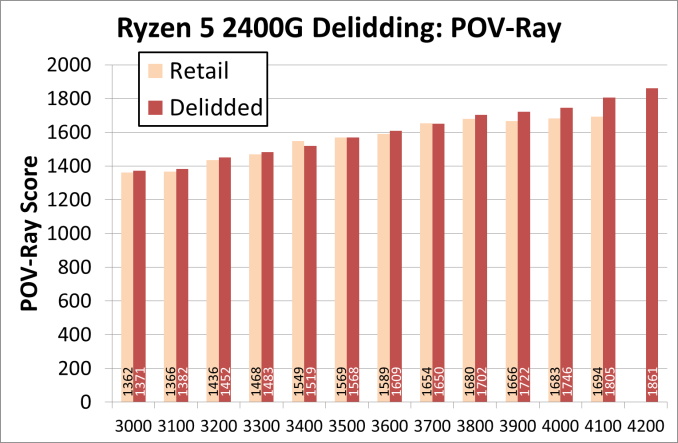








73 Comments
View All Comments
Ian Cutress - Thursday, May 10, 2018 - link
AMD does use solder on the Ryzen CPUs. It's the APUs that have paste. They do market the Ryzen-2000 CPUs as having higher-grade Indium-Tin solder.eastcoast_pete - Thursday, May 10, 2018 - link
Hi Ian, I should have been more precise: it's exactly because AMD "does the right thing" and uses solder for its non-APU Ryzen 2000 chips that this use of paste sticks out. I wish they would do so also for their Ryzen APU lines. Would make anyone considering buying a 2200G or 2400G feel less like a second - class customer, and emphasize the perception that this is a premium productOxford Guy - Thursday, May 10, 2018 - link
"Would make anyone considering buying a 2200G or 2400G feel less like a second - class customer, and emphasize the perception that this is a premium product"Intel hasn't had much trouble convincing people to spend a lot more on its second-class customer CPUs. It has been selling quite a lot of them since Sandy.
werpu - Wednesday, May 16, 2018 - link
Well the article was exaggerating the problem. There nowhere was a package difference of 12c in their numbers, as far as I remember in the upper area of 4.1 GHz it was 9c (from 67 down to 58). Sure they got another 100MHz out of it, but that is playing the silicon lottery area.So in reality depending on your workload the difference between the liquid cooling method and the a stock cooling via the usual ways is 4-9 degrees. This is not worth it. They might have shaved off 2-7 degrees by going full solder, but we are talking about cheap apus here. This is not an Intel like situation where the difference often is in the 15-25c degrees range due to cheap stuff being used.
Lolimaster - Thursday, May 10, 2018 - link
Why techsites and techtoubers don't understand, temps is not what is holding Ryzen or Ryzen APU's, is the way they designed the 1st iteration for a mobile oriented node.OCing the cpu part of the APU is WORTHLESS when the base clock is already 3.6Ghz, without delidding, any 2400G will do 1500Mhz+ on the gpu (good ones 1700 @1.3v for the soc voltage, the max for safety)
The benefit for delidding the APU is basically lower temps, specially when using the stock HS or a low profile one.
eastcoast_pete - Thursday, May 10, 2018 - link
Agree. I am eagerly awaiting a GPU-only overclock article for these, both stock and delidded. Also, second the interest in seeing that comparison with the stock cooler. My main interest in these (especially the 2400G) is the price/value aspect, and I don't think that many will want to shell out well over 100 Euros or dollars for a fancy cooler.gavbon - Thursday, May 10, 2018 - link
There will be a iGPU scaling piece, it is in the pipeline, along with CPU frequency scaling and memory scaling on APU, iGPU and dGPUDiji1 - Friday, May 11, 2018 - link
>the way they designed the 1st iteration for a mobile oriented node.Hopefully that means we'll see some tablets with 3D gaming possibilities then!
Matt G - Thursday, May 10, 2018 - link
Great article. Was an interesting read but FYI: If you add the cost of all the parts it totals $247 dollars. For that price you could easily step up to a much faster Ryzen 7 1700 for the same price.Ian Cutress - Thursday, May 10, 2018 - link
Therein is the rub, unless you know someone with a delidding tool. But hey, people buy $2000 cars and spend $10k in mods.